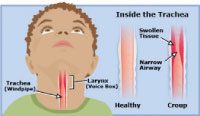Croup can be startling for both children and parents because of the noises the child makes. It sounds like a crowing, as the sufferer breathes in, accompanied by a barking cough and hoarseness. Dr Jinan Harith Darwish explains what to look for.
Croup is caused by a virus. Before a child gets it, he or she may have already had a runny nose, a cold, hoarseness and a higher temperature than normal. It often starts out like a normal cold followed by a harsh, barking cough which may be worse at night when the air is cooler.
Croup affects the child’s voice box, windpipe and small tubes in the lungs. Swelling makes the airway narrower, so it is harder to breathe. The condition usually affects children aged from three months to five years and some get croup several times.
 A mild case can be treated at home. If your child has a fever, painkillers, such as paracetamol, will help to lower their temperature. You should also give lots of fluids to ensure your child remains well hydrated. Don’t give any medicine that may make the child drowsy as little ones often find it easier to breathe when they are alert. While your child is sleeping, propping them up with pillows may make it easier for them to breathe.
A mild case can be treated at home. If your child has a fever, painkillers, such as paracetamol, will help to lower their temperature. You should also give lots of fluids to ensure your child remains well hydrated. Don’t give any medicine that may make the child drowsy as little ones often find it easier to breathe when they are alert. While your child is sleeping, propping them up with pillows may make it easier for them to breathe.
It’s key to keep sufferers away from smoky places as smoke may aggravate their airway. Do not smoke around your child and keep a window open to circulate fresh air.
Cough medicines, inhalers used to treat asthma and decongestants are of no benefit in treating croup.
If the youngster is distraught, sit them upright on your lap. It will also console and reassure the child by having you there. This is imperative because if your child is crying and distressed, it may make their symptoms worse.
Croup can get worse rapidly. If your child is having trouble breathing they should be seen by a doctor as soon as possible.
 You should visit your paediatrician if you are worried about your child’s breathing. They may choose to prescribe soluble steroids to drink in water. A single dose of corticosteroids, which reduces inflammation and swelling, has been shown to assist children with mild, moderate and severe croup.
You should visit your paediatrician if you are worried about your child’s breathing. They may choose to prescribe soluble steroids to drink in water. A single dose of corticosteroids, which reduces inflammation and swelling, has been shown to assist children with mild, moderate and severe croup.
The presence of any of the following signs suggests impending respiratory failure and the child should be treated as though the respiratory distress is severe regardless of the severity of the other clinical signs: change in mental state, such as lethargy and listlessness or decreased level of consciousness; pallor, dusky appearance; a pounding heart. In children with impending respiratory failure, breathing may be laboured, a barking cough may not be prominent, stridor (wheezing) at rest may be hard to hear and sternal wall retractions may not be marked. A child who appears to be deteriorating but whose stridor appears to be improving has worsening airway obstruction and is at high risk of complete airway occlusion.





































